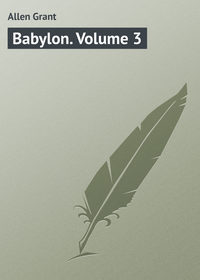 полная версия
полная версияFalling in Love; With Other Essays on More Exact Branches of Science
Against all such evil parental promptings, however, a great safeguard is afforded to society by the wholesome and essentially philosophical teaching of romance and poetry. I do not approve of novels. They are for the most part a futile and unprofitable form of literature; and it may profoundly be regretted that the mere blind laws of supply and demand should have diverted such an immense number of the ablest minds in England, France, and America, from more serious subjects to the production of such very frivolous and, on the whole, ephemeral works of art. But the novel has this one great counterpoise of undoubted good to set against all the manifold disadvantages and shortcomings of romantic literature—that it always appeals to the true internal promptings of inherited instinct, and opposes the foolish and selfish suggestions of interested outsiders. It is the perpetual protest of poor banished human nature against the expelling pitchfork of calculating expediency in the matrimonial market. While parents and moralists are for ever saying, 'Don't marry for beauty; don't marry for inclination; don't marry for love: marry for money, marry for social position, marry for advancement, marry for our convenience, not for your own,' the romance-writer is for ever urging, on the other hand, 'Marry for love, and for love only.' His great theme in all ages has been the opposition between parental or other external wishes and the true promptings of the young and unsophisticated human heart. He has been the chief ally of sentiment and of nature. He has filled the heads of all our girls with what Sir George Campbell describes off-hand as 'foolish ideas about love.' He has preserved us from the hateful conventions of civilisation. He has exalted the claims of personal attraction, of the mysterious native yearning of heart for heart, of the indefinite and indescribable element of mutual selection; and, in so doing, he has unconsciously proved himself the best friend of human improvement and the deadliest enemy of all those hideous 'social lies which warp us from the living truth.' His mission is to deliver the world from Dr. Johnson and Sir George Campbell.
For, strange to say, it is the moralists and the doctrinaires who are always in the wrong: it is the sentimentalists and the rebels who are always in the right in this matter. If the common moral maxims of society could have had their way—if we had all chosen our wives and our husbands, not for their beauty or their manliness, not for their eyes or their moustaches, not for their attractiveness or their vivacity, but for their 'sterling qualities of mind and character,' we should now doubtless be a miserable race of prigs and bookworms, of martinets and puritans, of nervous invalids and feeble idiots. It is because our young men and maidens will not hearken to these penny-wise apophthegms of shallow sophistry—because they often prefer Romeo and Juliet to the 'Whole Duty of Man,' and a beautiful face to a round balance at Coutts's—that we still preserve some vitality and some individual features, in spite of our grinding and crushing civilisation. The men who marry balances, as Mr. Galton has shown, happily die out, leaving none to represent them: the men who marry women they have been weak enough and silly enough to fall in love with, recruit the race with fine and vigorous and intelligent children, fortunately compounded of the complementary traits derived from two fairly contrasted and mutually reinforcing individualities.
I have spoken throughout, for argument's sake, as though the only interest to be considered in the married relation were the interests of the offspring, and so ultimately of the race at large, rather than of the persons themselves who enter into it. But I do not quite see why each generation should thus be sacrificed to the welfare of the generations that afterwards succeed it. Now it is one of the strongest points in favour of the system of falling in love that it does, by common experience in the vast majority of instances, assort together persons who subsequently prove themselves thoroughly congenial and helpful to one another. And this result I look upon as one great proof of the real value and importance of the instinct. Most men and women select for themselves partners for life at an age when they know but little of the world, when they judge but superficially of characters and motives, when they still make many mistakes in the conduct of life and in the estimation of chances. Yet most of them find in after days that they have really chosen out of all the world one of the persons best adapted by native idiosyncrasy to make their joint lives enjoyable and useful. I make every allowance for the effects of habit, for the growth of sentiment, for the gradual approximation of tastes and sympathies; but surely, even so, it is a common consciousness with every one of us who has been long married, that we could hardly conceivably have made ourselves happy with any of the partners whom others have chosen; and that we have actually made ourselves so with the partners we chose for ourselves under the guidance of an almost unerring native instinct. Yet adaptation between husband and wife, so far as their own happiness is concerned, can have had comparatively little to do with the evolution of the instinct, as compared with adaptation for the joint production of vigorous and successful offspring. Natural selection lays almost all the stress on the last point, and hardly any at all upon the first one. If, then, the instinct is found on the whole so trustworthy in the minor matter, for which it has not specially been fashioned, how far more trustworthy and valuable must it probably prove in the greater matter—greater, I mean, as regards the interests of the race—for which it has been mainly or almost solely developed!
I do not doubt that, as the world goes on, a deeper sense of moral responsibility in the matter of marriage will grow up among us. But it will not take the false direction of ignoring these our profoundest and holiest instincts. Marriage for money may go; marriage for rank may go; marriage for position may go; but marriage for love, I believe and trust, will last for ever. Men in the future will probably feel that a union with their cousins or near relations is positively wicked; that a union with those too like them in person or disposition is at least undesirable; that a union based upon considerations of wealth or any other consideration save considerations of immediate natural impulse, is base and disgraceful. But to the end of time they will continue to feel, in spite of doctrinaires, that the voice of nature is better far than the voice of the Lord Chancellor or the Royal Society; and that the instinctive desire for a particular helpmate is a surer guide for the ultimate happiness, both of the race and of the individual, than any amount of deliberate consultation. It is not the foolish fancies of youth that will have to be got rid of, but the foolish, wicked, and mischievous interference of parents or outsiders.
RIGHT AND LEFT
Adult man is the only animal who, in the familiar scriptural phrase, 'knoweth the right hand from the left.' This fact in his economy goes closely together with the other facts, that he is the only animal on this sublunary planet who habitually uses a knife and fork, articulate language, the art of cookery, the common pump, and the musical glasses. His right-handedness, in short, is part cause and part effect of his universal supremacy in animated nature. He is what he is, to a great extent, 'by his own right hand;' and his own right hand, we may shrewdly suspect, would never have differed at all from his left were it not for the manifold arts and trades and activities he practises.
It was not always so, when wild in woods the noble savage ran. Man was once, in his childhood on earth, what Charles Reade wanted him again to be in his maturer centuries, ambidextrous. And lest any lady readers of this volume—in the Cape of Good Hope, for example, or the remoter portions of the Australian bush, whither the culture of Girton and the familiar knowledge of the Latin language have not yet penetrated—should complain that I speak with unknown tongues, I will further explain for their special benefit that ambidextrous means equally-handed, using the right and the left indiscriminately. This, as Mr. Andrew Lang remarks in immortal verse, 'was the manner of Primitive Man.' He never minded twopence which hand he used, as long as he got the fruit or the scalp he wanted. How could he when twopence wasn't yet invented? His mamma never said to him in early youth, 'Why-why,' or 'Tomtom,' as the case might be, 'that's the wrong hand to hold your flint-scraper in.' He grew up to man's estate in happy ignorance of such minute and invidious distinctions between his anterior extremities. Enough for him that his hands could grasp the forest boughs or chip the stone into shapely arrows; and he never even thought in his innocent soul which particular hand he did it with.
How can I make this confident assertion, you ask, about a gentleman whom I never personally saw, and whose habits the intervention of five hundred centuries has precluded me from studying at close quarters? At first sight, you would suppose the evidence on such a point must be purely negative. The reconstructive historian must surely be inventing à priori facts, evolved, more Germanico, from his inner consciousness. Not so. See how clever modern archæology has become! I base my assertion upon solid evidence. I know that Primitive Man was ambidextrous, because he wrote and painted just as often with his left as with his right, and just as successfully.
This seems once more a hazardous statement to make about a remote ancestor, in the age before the great glacial epoch had furrowed the mountains of Northern Europe; but, nevertheless, it is strictly true and strictly demonstrable. Just try, as you read, to draw with the forefinger and thumb of your right hand an imaginary human profile on the page on which these words are printed. Do you observe that (unless you are an artist, and therefore sophisticated) you naturally and instinctively draw it with the face turned towards your left shoulder? Try now to draw it with the profile to the right, and you will find it requires a far greater effort of the thumb and fingers. The hand moves of its own accord from without inward, not from within outward. Then, again, draw with your left thumb and forefinger another imaginary profile, and you will find, for the same reason, that the face in this case looks rightward. Existing savages, and our own young children, whenever they draw a figure in profile, be it of man or beast, with their right hand, draw it almost always with the face or head turned to the left, in accordance with this natural human instinct. Their doing so is a test of their perfect right-handedness.
But Primitive Man, or at any rate the most primitive men we know personally, the carvers of the figures from the French bone-caves, drew men and beasts, on bone or mammoth-tusk, turned either way indiscriminately. The inference is obvious. They must have been ambidextrous. Only ambidextrous people draw so at the present day; and indeed to scrape a figure otherwise with a sharp flint on a piece of bone or tooth or mammoth-tusk would, even for a practised hand, be comparatively difficult.
I have begun my consideration of rights and lefts with this one very clear historical datum, because it is interesting to be able to say with tolerable certainty that there really was a period in our life as a species when man in the lump was ambidextrous. Why and how did he become otherwise? This question is not only of importance in itself, as helping to explain the origin and source of man's supremacy in nature—his tool-using faculty—but it is also of interest from the light it casts on that fallacy of poor Charles Reade's already alluded to—that we ought all of us in this respect to hark back to the condition of savages. I think when we have seen the reasons which make civilised man now right-handed, we shall also see why it would be highly undesirable for him to return, after so many ages of practice, to the condition of his undeveloped stone-age ancestors.
The very beginning of our modern right-handedness goes back, indeed, to the most primitive savagery. Why did one hand ever come to be different in use and function from another? The answer is, because man, in spite of all appearances to the contrary, is really one-sided. Externally, indeed, his congenital one-sidedness doesn't show: but it shows internally. We all of us know, in spite of Sganarelle's assertion to the contrary, that the apex of the heart inclines to the left side, and that the liver and other internal organs show a generous disregard for strict and formal symmetry. In this irregular distribution of those human organs which polite society agrees to ignore, we get the clue to the irregularity of right and left in the human arm, and finally even the particular direction of the printed letters now before you.
For primitive man did not belong to polite society. His manners were strikingly deficient in that repose which stamps the caste of Vere de Vere. When primitive man felt the tender passion steal over his soul, he lay in wait in the hush for the Phyllis or Daphne whose charms had inspired his heart with young desire; and when she passed his hiding-place, in maiden meditation, fancy free, he felled her with a club, caught her tight by the hair of her head, and dragged her off in triumph to his cave or his rock-shelter. (Marriage by capture, the learned call this simple mode of primeval courtship.) When he found some Strephon or Damœtas rival him in the affections of the dusky sex, he and that rival fought the matter out like two bulls in a field; and the victor and his Phyllis supped that evening off the roasted remains of the vanquished suitor. I don't say these habits and manners were pretty; but they were the custom of the time, and there's no good denying them.
Now, Primitive Man, being thus by nature a fighting animal, fought for the most part at first with his great canine teeth, his nails, and his fists; till in process of time he added to these early and natural weapons the further persuasions of a club or shillelagh. He also fought, as Darwin has very conclusively shown, in the main for the possession of the ladies of his kind, against other members of his own sex and species. And if you fight, you soon learn to protect the most exposed and vulnerable portion of your body; or, if you don't, natural selection manages it for you, by killing you off as an immediate consequence. To the boxer, wrestler, or hand-to-hand combatant, that most vulnerable portion is undoubtedly the heart. A hard blow, well delivered on the left breast, will easily kill, or at any rate stun, even a very strong man. Hence, from a very early period, men have used the right hand to fight with, and have employed the left arm chiefly to cover the heart and to parry a blow aimed at that specially vulnerable region. And when weapons of offence and defence supersede mere fists and teeth, it is the right hand that grasps the spear or sword, while the left holds over the heart for defence the shield or buckler.
From this simple origin, then, the whole vast difference of right and left in civilised life takes its beginning. At first, no doubt, the superiority of the right hand was only felt in the matter of fighting. But that alone gave it a distinct pull, and paved the way, at last, for its supremacy elsewhere. For when weapons came into use, the habitual employment of the right hand to grasp the spear, sword, or knife made the nerves and muscles of the right side far more obedient to the control of the will than those of the left. The dexterity thus acquired by the right—see how the very word 'dexterity' implies this fact—made it more natural for the early hunter and artificer to employ the same hand preferentially in the manufacture of flint hatchets, bows and arrows, and in all the other manifold activities of savage life. It was the hand with which he grasped his weapon; it was therefore the hand with which he chipped it. To the very end, however, the right hand remains especially 'the hand in which you hold your knife;' and that is exactly how our own children to this day decide the question which is which, when they begin to know their right hand from their left for practical purposes.
A difference like this, once set up, implies thereafter innumerable other differences which naturally flow from it. Some of them are extremely remote and derivative. Take, for example, the case of writing and printing. Why do these run from left to right? At first sight such a practice seems clearly contrary to the instinctive tendency I noticed above—the tendency to draw from right to left, in accordance with the natural sweep of the hand and arm. And, indeed, it is a fact that all early writing habitually took the opposite direction from that which is now universal in western countries. Every schoolboy knows, for instance (or at least he would if he came up to the proper Macaulay standard), that Hebrew is written from right to left, and that each book begins at the wrong cover. The reason is that words, and letters, and hieroglyphics were originally carved, scratched, or incised, instead of being written with coloured ink, and the hand was thus allowed to follow its natural bent, and to proceed, as we all do in naïve drawing, with a free curve from the right leftward.
Nevertheless, the very same fact—that we use the right hand alone in writing—made the letters run the opposite way in the end; and the change was due to the use of ink and other pigments for staining papyrus, parchment, or paper. If the hand in this case moved from right to left it would of course smear what it had already written; and to prevent such untidy smudging of the words, the order of writing was reversed from left rightward. The use of wax tablets also, no doubt, helped forward the revolution, for in this case, too, the hand would cover and rub out the words written.
The strict dependence of writing, indeed, upon the material employed is nowhere better shown than in the case of the Assyrian cuneiform inscriptions. The ordinary substitute for cream-laid note in the Euphrates valley in its palmy days was a clay or terra-cotta tablet, on which the words to be recorded—usually a deed of sale or something of the sort—were impressed while it was wet and then baked in, solid. And the method of impressing them was very simple; the workman merely pressed the end of his graver or wedge into the moist clay, thus giving rise to triangular marks which were arranged in the shapes of various letters. When alabaster, or any other hard material, was substituted for clay, the sculptor imitated these natural dabs or triangular imprints; and that was the origin of those mysterious and very learned-looking cuneiforms. This, I admit, is a palpable digression; but inasmuch as it throws an indirect light on the simple reasons which sometimes bring about great results, I hold it not wholly alien to the present serious philosophical inquiry.
Printing, in turn, necessarily follows the rule of writing, so that in fact the order of letters and words on this page depends ultimately upon the remote fact that primitive man had to use his right hand to deliver a blow, and his left to parry, or to guard his heart.
Some curious and hardly noticeable results flow once more from this order of writing from left to right. You will find, if you watch yourself closely, that in examining a landscape, or the view from a hill-top, your eye naturally ranges from left to right; and that you begin your survey, as you would begin reading a page of print, from the left-hand corner. Apparently, the now almost instinctive act of reading (for Dogberry was right after all, for the civilised infant) has accustomed our eyes to this particular movement, and has made it especially natural when we are trying to 'read' or take in at a glance the meaning of any complex and varied total.
In the matter of pictures, I notice, the correlation has even gone a step farther. Not only do we usually take in the episodes of a painting from left to right, but the painter definitely and deliberately intends us so to take them in. For wherever two or three distinct episodes in succession are represented on a single plane in the same picture—as happens often in early art—they are invariably represented in the precise order of the words on a written or printed page, beginning at the upper left-hand corner, and ending at the lower right-hand angle. I first noticed this curious extension of the common principle in the mediæval frescoes of the Campo Santo at Pisa; and I have since verified it by observations on many other pictures elsewhere, both ancient and modern. The Campo Santo, however, forms an exceptionally good museum of such story-telling frescoes by various painters, as almost every picture consists of several successive episodes. The famous Benozzo Gozzoli, for example, of Noah's Vineyard represents on a single plane all the stages in that earliest drama of intoxication, from the first act of gathering the grapes on the top left, to the scandalised lady, the vergognosa di Pisa, who covers her face with her hands in shocked horror at the patriarch's disgrace in the lower right-hand corner.
Observe, too, that the very conditions of technique demand this order almost as rigorously in painting as in writing. For the painter will naturally so work as not to smudge over what he has already painted: and he will also naturally begin with the earliest episode in the story he unfolds, proceeding to the others in due succession. From which two principles it necessarily results that he will begin at the upper left, and end at the lower right-hand corner.
I have skipped lightly, I admit, over a considerable interval between primitive man and Benozzo Gozzoli. But consider further that during all that time the uses of the right and left hand were becoming by gradual degrees each day still further differentiated and specialised. Innumerable trades, occupations, and habits imply ever-widening differences in the way we use them. It is not the right hand alone that has undergone an education in this respect: the left, too, though subordinate, has still its own special functions to perform. If the savage chips his flints with a blow of the right, he holds the core, or main mass of stone from which he strikes it, firmly with his left. If one hand is specially devoted to the knife, the other grasps the fork to make up for it. In almost every act we do with both hands, each has a separate office to which it is best fitted. Take, for example, so simple a matter as buttoning one's coat, where a curious distinction between the habits of the sexes enables us to test the principle with ease and certainty. Men's clothes are always made with the buttons on the right side and the button-holes on the left. Women's, on the contrary, are always made with the buttons on the left side, and the button-holes on the right. (The occult reason for this curious distinction, which has long engaged the attention of philosophers, has never yet been discovered, but it is probably to be accounted for by the perversity of women.) Well, if a man tries to put on a woman's waterproof, or a woman to put on a man's ulster, each will find that neither hand is readily able to perform the part of the other. A man, in buttoning, grasps the button in his right hand, pushes it through with his right thumb, holds the button-hole open with his left, and pulls all straight with his right fore-finger. Reverse the sides, and both hands at once seem equally helpless.
It is curious to note how many little peculiarities of dress or manufacture are equally necessitated by this prime distinction of right and left. Here are a very few of them, which the reader can indefinitely increase for himself. (I leave out of consideration obvious cases like boots and gloves: to insult that proverbially intelligent person's intelligence with those were surely unpardonable.) A scarf habitually tied in a sailor's knot acquires one long side, left, and one short one, right, from the way it is manipulated by the right hand; if it were tied by the left, the relations would be reversed. The spiral of corkscrews and of ordinary screws turned by hand goes in accordance with the natural twist of the right hand: try to drive in an imaginary corkscrew with the right hand, the opposite way, and you will see how utterly awkward and clumsy is the motion. The strap of the flap that covers the keyhole in trunks and portmanteaus always has its fixed side over to the right, and its buckle to the left; in this way only can it be conveniently buckled by a right-handed person. The hands of watches and the numbers of dial-faced barometers run from left to right: this is a peculiarity dependent upon the left to right system of writing. A servant offers you dishes from the left side: you can't so readily help yourself from the right, unless left-handed. Schopenhauer despaired of the German race, because it could never be taught like the English to keep to the right side of the pavement in walking. A sword is worn at the left hip: a handkerchief is carried in the right pocket, if at the side; in the left, if in the coat-tails: in either case for the right hand to get at it most easily. A watch-pocket is made in the left breast; a pocket for railway tickets halfway down the right side. Try to reverse any one of these simple actions, and you will see at once that they are immediately implied in the very fact of our original right-handedness.









